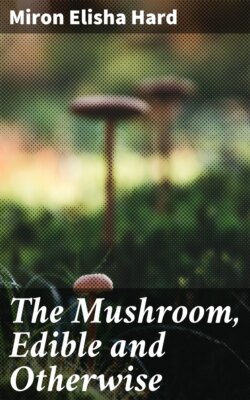Читать книгу The Mushroom, Edible and Otherwise - Miron Elisha Hard - Страница 12
На сайте Литреса книга снята с продажи.
Family 1—Agaricaceae.
ОглавлениеFigure 7.—Spore-print of Agaricus arvensis.
In the Agaricaceæ or common mushrooms, and in all other of similar structure, the spore-producing membranes are found on the under surface of the cap. They consist of thin lamellæ, or gills, attached by the upper edge to the cap and extending from the stem to the margin of the cap. Very frequently that space may be entirely utilized by shorter lamellæ, or gills, intervening between the longer, especially toward the margin of the cap. In a few species where the stem seems to be wanting, or where it is attached to the side of the cap, the lamellæ, or gills, radiate from the point of attachment or from the lateral stem to other parts of the circumference of the cap. Berkeley gives the following characteristics: Hymenium, inferior, spread over easily divisible gills or plates, radiating from a center or stem, which may be either simple or branched.
This family includes the following genera:
1 Agaricus—Gills, not melting, edge acute; including all the sub-genera which have been elevated to the rank of genera.
2 Coprinus—Gills deliquescent, spores black.
3 Cortinarius—Gills persistent, veil spider-web-like, terrestrial.
4 Paxillus—Gills separating from the hymenophorum and decurrent.
5 Gomphidius—Gills branched and decurrent, pileus top-shaped.
6 Bolbitius—Gills becoming moist, spores colored.
7 Lactarius—Gills milky, terrestrial.
8 Russula—Gills equal, rigid, and brittle, terrestrial.
9 Marasmius—Gills thick, tough, hymenium dry.
10 Hygrophorus—Stem confluent with the hymenophorum; gills sharp edged.
11 Cantharellus—Gills thick, branched, rounded edge.
12 Lentinus—Pileus hairy, hard, tough; gills, tough, unequal, toothed; on logs and stumps.
13 Lenzites—Whole plant corky; gills simple or branched.
14 Trogia—Gills venose, fold-like, channelled.
15 Panus—Gills corky, with acute edge.
16 Nyctalis—Veil universal; gills broad, often parasitic.
17 Schizophyllum—Gills corky, split longitudinally.
18 Xerotus—Gills tough, fold-like.
Therefore the gill-bearing fungi are known under the family name, Agaricaceæ, or more generally known as Agarics.
Figure 8.—Spore-print of Hypholoma sublatertium.
This family is divided into five series, according to the color of their spores. The spores when seen in masses possess certain colors, white, rosy, rusty, purple-brown and black. Therefore the first and most important part to be determined in locating a mushroom is to ascertain the color of the spores. To do this, take a fresh, perfect, and fully developed specimen, remove the stem from the cap. Place the cap with the gills downward on the surface of dark velvety paper, if you suspect the spores to be white. Invert a finger bowl or a bell glass over the cap to keep the air from blowing the spores away. If the spores should be colored, white paper should be used. If the specimen is left too long the spore deposit will continue upward between the gills and it may reach an eighth of an inch in height, in which case if great care is taken in removing the cap there will be a perfect likeness of the gills and also the color of the spores.
Figure 9.—Spore-print of a Flammula.
There are two ways of making these spore prints quite permanent. First take a piece of thin rice paper, muscilage it and allow it to dry, then proceed as above. In this way the print will stand handling quite a little. Another way, and that used to prepare the spore-prints in these photographs, is to obtain the spore-print upon Japanese paper as in the preceding method, then by an atomizer spray the print gently and carefully with a fixative such as is used in fixing charcoal drawings. Success in making spore-prints requires both time and care, but the satisfaction they give is ample recompense for the trouble. It is more difficult to obtain good prints from the white-spored mushrooms than from those bearing colored spores, because it is hard to obtain a black paper having a dull velvety surface, and the spores will not adhere well to a smooth-finished, glossy paper. For the prints illustrated I am indebted to Mrs. Blackford.
Figure 10.—Spore-print of a Boletus.
If the plant is dry it is well to moisten the fingerbowl or bell-glass on the inside before placing it over the mushroom. The spores of Boleti, and, indeed, all fungi can be caught and fixed in the same way.
From the study of these spore-prints we shall find five different colors of spores. This family is, therefore, divided into five series, determined by the color of the spores, which are always constant in color, size and shape.
The five series will be treated in the following order:
1 The white-spored Agarics.
2 The rosy-spored Agarics.
3 The rusty-spored Agarics.
4 The purple-brown-spored Agarics.
5 The black-spored Agarics.
